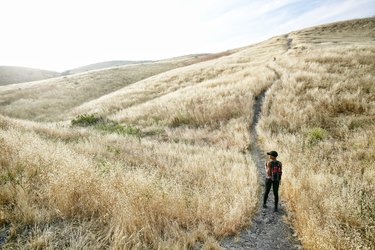
Lots of people exercise with the hopes that they burn some fat. But, just how much exercise does it take to burn 14 grams of fat?
Lower-intensity exercise gets roughly 60 percent of its fuel from fat, whereas fat provides about 35 percent of the calories burned in higher-intensity workouts, according to Sports Coach Brian Mac. However, higher-intensity workouts of similar duration burn more calories overall and result in more body weight and fat loss. Your metabolism remains elevated after a high-intensity workout, adding to your overall calorie deficit.
Video of the Day
Video of the Day
Start with an exercise program that matches your fitness level, continuing to burn excess fat while you gradually increase the intensity of your workouts. Consult with your doctor before starting an exercise program if you've been inactive, have a history of heart or orthopedic problems or have risk factors for heart disease.
Read more: Monounsaturated Fat Vs. Polyunsaturated Fat
Tip
You need to burn 126 calories to equal the energy in 14 grams of fat. The amount of exercise you need to do to burn 126 calories depends on the intensity of your workout.
Burning Calories Vs. Burning Fat
To burn the equivalent of 14 grams of fat, you need to work off 126 calories. That's because 1 g of dietary fat contains 9 calories. Although you can easily burn the number of calories provided by 14 grams of fat, it won't make a difference if your caloric intake exceeds your expenditure. Unless you burn more than you consume, any excess energy will stick around in the form of triglycerides, or stored fat.
The Fastest Fat Burner
While there's no such thing as the fastest fat burner, you have several options for burning 126 calories, including 30 minutes of walking, doing water aerobics or dancing, according to Harvard Health Publishing. Other possibilities include outdoor activities such as gardening, raking the lawn or mowing the grass. If you choose a more vigorous activity such as running at 5 mph or bicycling at more than 10 mph, you can burn the calories more quickly.
Even though you can't direct your body to burn calories specifically from the 14 grams of fat you consumed, exercise contributes to health and weight management by improving your fitness and keeping excess calories in check. In the context of a healthy diet, however, 14 grams of fat is far from too many.
Read more: How to Lose Back Fat and Armpit Fat
Consider Your Diet
According to the Centers for Disease Control and Prevention, the total amount of fat you consume is less important than the quality of fat in your diet. The CDC states that less than 10 percent of your diet should come from saturated fats. If you consume too much saturated or trans fat from your diet, your cholesterol level may be negatively affected, even if you exercise. While exercise is a healthy way to burn excess fat, it's equally important to include the right kinds of fats in your diet.
When you establish a calorie deficit by taking in fewer calories than you expend, you burn excess body fat. This is true regardless of the source of fuel used during exercise. Body fat is the result of excess calories from all sources, including dietary fat, carbohydrates and protein. To keep from storing additional body fat, you need to monitor your caloric intake and get regular exercise.